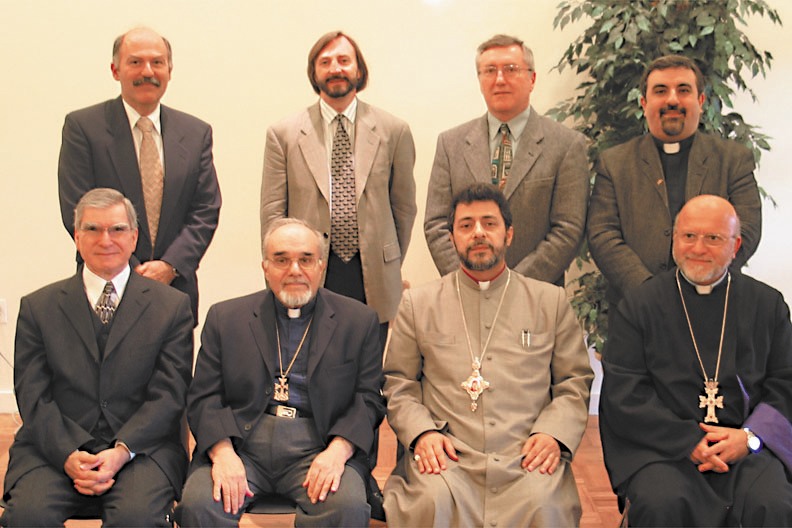Staff Report
 Barlow Der Mugrdechian of the Armenian Studies Program co-organized and participated in an international conference “The Armenian Bible: Celebrating the 1600th Anniversary of the Discovery of the Armenian Alphabet and the Translation of the Bible into Armenian” under the auspices of His Eminence Archbishop Hovnan Derderian and the Western Diocese of the Armenian Church of North America.
Barlow Der Mugrdechian of the Armenian Studies Program co-organized and participated in an international conference “The Armenian Bible: Celebrating the 1600th Anniversary of the Discovery of the Armenian Alphabet and the Translation of the Bible into Armenian” under the auspices of His Eminence Archbishop Hovnan Derderian and the Western Diocese of the Armenian Church of North America.
The conference was also dedicated to the 30th anniversary of the Society for Armenian Studies. Dr. Kenneth R. Nielsen, President of Woodbury University gave the opening remarks for the conference, welcoming guests to the historic campus of Woodbury University.
Prof. Barlow Der Mugrdechian opened the conference with a paper on “The Bible and Armenian Culture” and served as moderator. His paper traced the substantial influence of the Bible in Armenian art, architecture, and literature. The translation of the Bible into Armenian in the first part of the fifth century proved to be a significant moment in the history of the Armenian people.
Six papers were read on various aspects of the study of Bible translation. The morning session included Dr. Claude Cox, Adjunct Associate Professor of Old Testament and Hebrew at McMaster Divinity College, Hamilton, Ontario, speaking on “Little Words are Important Too: The Use of Particles in the Armenian Translation of Job.” Dr. Cox commented on the treatment of particles in the Armenian translation of Job and how the translator treated all the little words. Several years ago he gave a paper on the Old Greek of Job and its treatment of particles when the Hebrew was translated and his paper touched on similar issues for the Armenian.
He was followed by Rev. Dr. Manuel M. Jinbachian, Professor of Septuagint at McGill University in Canada, speaking on “The Prophecy of Jeremiah as it is Found in the Hebrew, Septuagint, Syriac, and Armenian.” Dr. Jinbachian took the first two chapters of Jeremiah and compared the three ancient versions, Hebrew, Syriac, and Septuagint, and tried to establish where the Armenian version comes from. He stated that the Armenian follows the Greek very closely in the first two chapters.
Participants and guests had the opportunity for questions and answers at the conclusion of each paper.
Very Rev. Fr. Dr. Vahan Hovhanessian, affiliated with St. Nersess Armenian Seminary, New Rochelle, NY, spoke on “The Reading is From Third Corinthians-A Glance at the Lectionary of the Armenian Church.” This paper shed light on the various passages from 3 Corinthians that have been incorporated in the liturgical calendar of the Armenian Church. Exploring 10 different manuscripts of Armenian lectionaries Fr. Hovhanessian traced the various readings from 3 Corinthians in the liturgical calendar of the Armenian Church and examined their contexts. This further supported the argument for the canonical status that 3 Corinthians enjoyed in the Armenian Church.
Very Rev. Fr. Dajad Yardemian, Vicar General of the Western Diocese and one of the co-organizers of the conference, spoke in Armenian on “Armenian Exegesis or Armenian Commentaries on the Books of the Holy Bible: 5th-18th centuries.” He referred to the depth of Armenian exegetical works and to their rich spirituality, and provided an evaluation from the theological, ecclesiastical and dogmatic point of view, emphasizing at the same time their high value of moral instruction within the spiritual life. He concluded that today the exegetical works of the Armenian Church Fathers still maintain their contemporary value, as they are a living history of the Christian faith, which is directly connected to our current life of faith.
Following a lunch break, the second part of the conference began with a paper from Dr. Peter Cowe, Narekatsi Chair of Armenian Studies, UCLA, speaking on “Literary and Theological Considerations Governing the Strata of the Armenian Version of Scripture.” Dr. Cowe discussed a number of issues relating to the Armenian translation of the Bible. His paper contextualized the undertaking within the evangelization of Southern Caucasia and explored examples of the exegesis of the School of Edessa, which proved a formative influence on Armenian Christianity.
Rev. Fr. Dr. Zaven Arzoumanian, Pastor of St. Gregory Armenian Apostolic Church, Pasadena, spoke in Armenian on “The Armenian Bible and the Early Formation of the Armenian Church.” The Armenian Church, already established one century and a half earlier by St. Gregory the Illuminator (301AD) and his successors, gained ultimate merits from the newly translated Bible. The worship services and the sacraments formed and established by the Armenian church leaders in the 4th century were very inadequate until the Armenian version of the Bible came to the rescue. These liturgical books were immensely enriched by the citations and the allusions of the Bible naturally and by necessity. The Canon Law of the Armenian Church, as well as the Hymnal (the sharagans) became the cornerstones of our Church, requiring the ultimate input of the Armenian Bible.
Closing remarks were made by Archbishop Hovnan Derderian, Primate of the Western Diocese of the Armenian Church of North America. Archbishop Derderian spoke on the importance of holding conferences such as these and stated that he would like to continue organizing such gatherings in the future.
The conference, held in cooperation with Woodbury University and Claremont University, took place on Saturday, February 25, 2006 in the Cabrini Hall of Woodbury University in Burbank.
 Hye Sharzhoom Armenian Action
Hye Sharzhoom Armenian Action